|
Last week the two best golfers on the planet over the last 10 years missed the cut at the Greenbrier Classic in White Sulphur Springs West Virginia. It’s the first time Tiger Woods and Phil Mickelson have missed the cut in the same tournament on the PGA Tour. On the flip side two relative unknowns Ted Potter Jnr. and Todd Kelly were involved in a playoff for the title with Ted Potter Jnr winning and becoming an instant millionaire. Coming into the tournament their rankings on the PGA tour money list were 167 and 199 respectively and both had missed the cut in half the tournaments they had played in. To add to this Ted Potter Jnr. had missed five cuts in a row coming into the Greenbrier Classic. 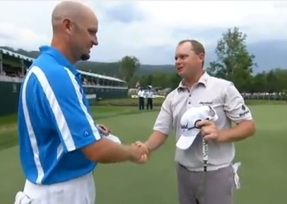 So what changed for these two professionals at Greenbrier? They had each shot 4 under after the half way cut (which was at 1 under) and the leader was at 9 under. Both had identical scores of 12 under (Ted Potter Jnr. 64-64 and Todd Kelly 62-66) on the weekend to finish on 16 under after 72 holes of regulation play. Was their ball striking the difference or was it their short game? As we do here at Pro Tour Golf College we strive to be as precise as we can to make sense of the stats to explain the reason why certain player’s score lower than the others. So crunching the numbers as Lawrie and I do, the one stat that both Ted and Todd were streets ahead of the field on- especially on the weekend was “Strokes Gained-Putting”. On Saturday and Sunday they were ranked one and two. Ted Potter gained 3.178 strokes on Saturday and 3.193 strokes on Sunday against the field. Todd Kelly gained 2.131 and 3.254 on the field.  So how does strokes gained putting work? The strokes gained putting stat has been in use on the PGA Tour since May 2011 and it was developed by Professor Mark Broadie from the Columbia Business School. He explains it as a stat that measures the number of putts a golfer takes relative to the PGA Tour average, taking into account the initial putt distance on each green. Well suppose for example a golfer one putts from 33 feet. The Tour average to hole out from that distance is 2.0 putts, so a one putt (see photo above) gains one stroke on the field. A two putt neither gains nor loses but a three putt represents a loss of one stroke against the field. From other distances, the strokes gained or lost are typically in fractions. For example, suppose a golfer one putts from eight feet. The Tour average (identified from ShotLink) is 1.5, so a one putt gains 0.5 strokes and a two putt loses 0.5 strokes. If a golfer putted ten times from eight feet and made half of them his strokes gained would be Zero—he gained 0.5 on five holes and lost 0.5 on the other five holes. Now if he made six and missed four, his strokes gained would be one. He gained 0.5 on six holes and lost 0.5 on four holes. This makes sense as he took 14 putts vs the Tour average of 15 from eight feet. 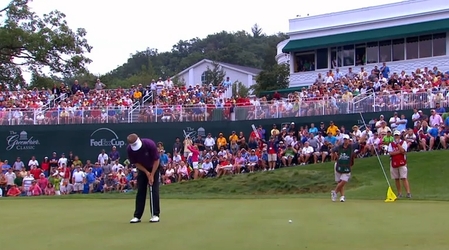 Strokes gained on each hole are added to give total strokes gained for round, tournament or year. This is a pure measure of a golfers putting skill compared to other stats e.g. total putts and putts per G.I.R. which mix sand skill, short game control and iron play into the equation. This is a much better way to measure your putting and it explains why proximity to hole is a major influence on your chances of making more putts verses missing. As a matter of interest Aaron Baddeley averages 0.808 per round and is currently leading this stat on the PGA Tour in 2012. Do you know what your strokes gained for putting is?... 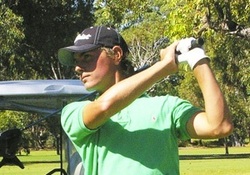 Pro tour Golf College students playing around the globe have had good results and continue to learn and adjust to life on tour. Jason Scrivener had a good tournament on the Canadian Tour at the Dakota Dunes Casino Open shooting 68-71-69-70 for a total of 10 under and 22nd position. The scoring was very low for this tournament but if Jason can maintain his competitive scoring average of 2.5 under per round he will put himself in contention to win tournaments in the coming months without a doubt. He’s playing in the Canadian Tour Players Cup this week and has started where he left off last week signing for a 4 under 67 and tie for 5th position. He takes a well earned break at the end of this week after six tournaments in a row. Two weeks in London catching up with friends and then to Thailand to play on the OneAsia Tour then back home to prepare for the end of year Aussie tournaments. 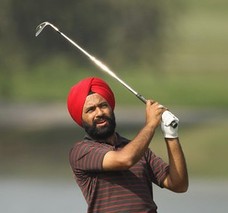 On the Asian Development Tour Zaw Moe from Myanmar who turned his game around at Pro Tour Golf College two years ago shot 69-69-68-69 (13 under) and tied 5th. The amazing stat was that he finished 9 behind the winner Sujjan Singh from India. So no matter where you play in the world the standard of professional golf is very high. Sujjan opened up with 64 and 63 on Thursday and Friday and lead by 9 strokes from Indonesia’s Rory Hie in 2nd place. Followed with a 67 in the 3rd round and coasted in with an even par 72 on the last day for a total of 22 under par. A player to watch in the near future.  Bramantio Adi or Ibam as he is affectionately known at Pro Tour Golf College enrolled in the Tour Player Bridging Program in April last year. He arrived with a handicap of 10 and a competitive stroke average of 84. A model student who has dedicated himself to playing successfully on a PGA TOUR in the near future. He is currently playing off a 2 handicap and has reduced his competitive stroke average to below 75. Ibam has been rewarded by getting into and playing in his first Pro tournament on the Asian Development Tour in Jakarta being played at the Imperial Golf Course. He shot 73 in the 1st round and is tied for 38th position. A remarkable achievement for someone who has been playing golf for less than 2 years. A former goalkeeper for the Indonesian National soccer team (under 18's) Ibam is showing what hard work combined with the proven training programs at PTGC can do to produce amazing results. 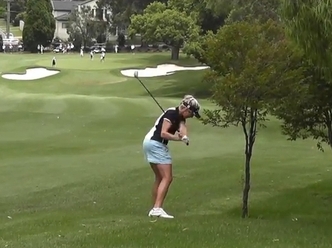 Danielle Montgomery is playing in the South Africa Ladies Open on the European Ladies Tour and we wish her all the best. Conditions should suit the girl from Perth. Tatiana Wijaya is T9th going into the last round of the Callaway World Junior in San Diego. A good last round will get her into the top 5 position. Go for it Tia!! Plenty of golf being played all over the world and the focus will be on the 3rd Major of the year. The British Open or “The Open” as its referred to by students of the game is the oldest golf major and history confirms that all great golf champions from every era have their name on it. This year it’s being played at Royal Lytham & St. Annes. Who will lift the claret jug this year? We'll let you know in next weeks newsletter, so stay tuned. Good Golfing, David & Lawrie - Pro Tour Golf College Comments are closed.
|
Archives
June 2019
|
Proudly Supported By
Copyright © 2011 - 2018 Pro Tour Golf College
Website Managed By Golf Performance Media
All Rights Reserved
Website Managed By Golf Performance Media
All Rights Reserved


 RSS Feed
RSS Feed



